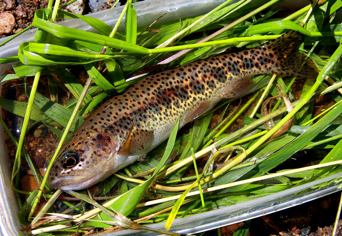A Better Path: Stewardship of the Metolius River Video of A Better Path: Stewardship of the Metolius River
Editor’s note: Happy Trout Tuesday! This is part of an ongoing series looking at an incredible and underloved species of fish – the interior redband trout – and a recently signed Conservation Agreement that will promote conservation of the species across six states.
As the U.S. Fish and Wildlife Service noted in their kick-off blog, “there’s finally something great about the second day of the week.”
Redband trout aren’t your run-of-the-mill fish.
They’re scrappy. And tough. Tenacious. They’re a fish that has been – really, has had to be – so terribly adaptable that they’ve found themselves surviving in places where most other trout would sooner throw in the towel.
Evolutionarily, they’re well-honed machines. Desert fish, if you can imagine such a thing.
“In my work in the region, I have found them clinging to shade and cover in intermittent streams, just waiting for a thunderstorm which will allow their stream to be connected with flowing water so they can move into better habitat,” says Darek Staab, project manager for Trout Unlimited’s Upper Deschutes Home Water’s Initiative. “I have also found them thriving in cold, spring fed water like the Metolius River, where they grow large and strong with a robust insect population. We even have those ambitious redbands, that decide to go to the ocean and join their steelhead cousins, and return to our Oregon rivers with a whole new character. With their diversity, impressive abilities to survive in desert rivers, and beautiful coloration, we are just happy to share our habitat with them.”
In short, something worth protecting.
Which is why Trout Unlimited, along with a handful of federal agencies and tribal governments across six states have signed on to an agreement that will help protect and restore this special species.
We’re no strangers to working with redbands. For instance:
- In 2010, the Spokane Falls chapter of TU spent nearly 500 volunteer hours making and putting up signs to educate the public about redband trout. The signs showed a picture of the redband to help with identification and highlighted the special fishing regulations designed to protect the fish.
- In the Owyhee Basin, TU’s Science Team uses imagery and data to guide where conservation projects will do the most good. Then boots hit the ground, and TU works with ranchers to keep those desert redbands going strong.
- In Oregon, with the help of Orvis, the National Fish and Wildlife Foundation, and the Western Native Trout Initiative, TU has removed culverts that had been blocking spawning habitat for decades – one on Crazy Creek and one on Indian Ford. These also helped open up areas of refuge for the fish as they sought deep cool pools to make it through the heat of the summer.
And those are just a few examples from a few states, from one small conservation organization. Now add multiple federal agencies, multiple states and start calculating what we can accomplish.



